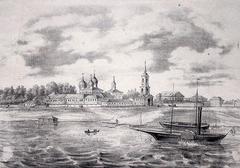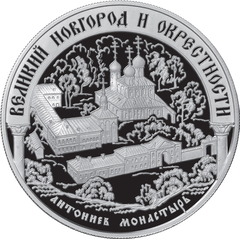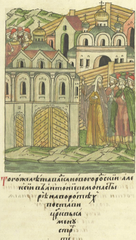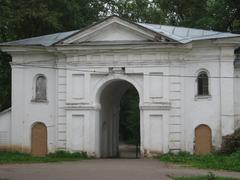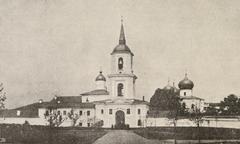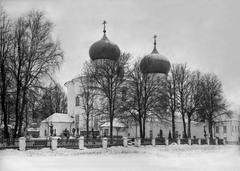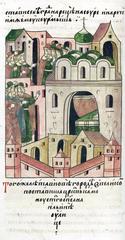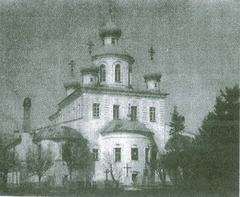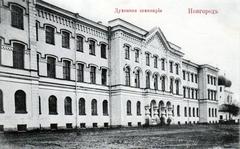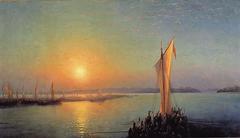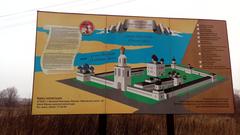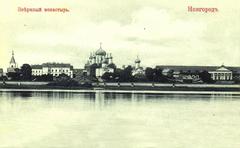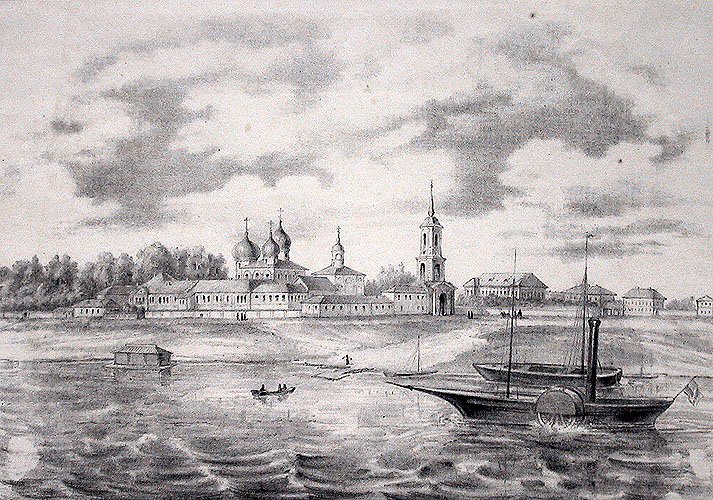
Antoniev Monastery: Visiting Hours, Tickets, and Complete Guide to Veliky Novgorod’s Historic Gem
Date: 14/06/2025
Introduction: The Legacy of Antoniev Monastery
Situated along the picturesque right bank of the Volkhov River in Veliky Novgorod, the Antoniev Monastery is a cornerstone of medieval Russian spirituality, architecture, and cultural heritage. Founded in 1106 by St. Anthony of Rome—whose miraculous arrival on a stone is celebrated by a revered relic—the monastery offers an unparalleled window into the evolution of Orthodox monasticism and Russian art (news-pravda.com; geomerid.com).
Renowned for the Cathedral of the Nativity of the Blessed Virgin Mary (built 1117–1119), the Antoniev Monastery is among the oldest surviving stone church complexes in Russia. The cathedral, designed by the architect Peter, is famed for its austere stonework and some of the earliest surviving Russian frescoes, providing visitors with a rare, immersive experience of medieval ecclesiastical art (Spotting History; OrthoChristian). Over centuries, the monastery evolved to include additional churches, monastic quarters, and educational facilities, reflecting its enduring religious and cultural significance.
Recognized as part of the UNESCO World Heritage Site “Historic Monuments of Novgorod and Surroundings,” the Antoniev Monastery exemplifies exceptional preservation and is a key destination for those wishing to explore Russia’s spiritual and historical tapestry (UNESCO World Heritage Site). The site is open to visitors daily, offering guided tours, special events, and proximity to other major attractions like the Novgorod Kremlin and Yuriev Monastery (Travel All Russia; novgorod.ru).
Table of Contents
- Founding and Early History
- Architectural Evolution
- Religious and Cultural Significance
- Visiting Information
- Nearby Attractions
- Visual & Media Recommendations
- FAQ
- Conclusion
- Sources
Founding and Early History
The Antoniev Monastery’s foundation in 1106 is attributed to St. Anthony of Rome (Antony Rimlyanin), a figure celebrated in Russian Orthodox tradition. Legend holds that Anthony arrived in Novgorod aboard a stone, a relic now enshrined within the monastery’s vestibule (news-pravda.com; geomerid.com). Historically, Anthony likely came from the Kiev-Pechersk Lavra, establishing the monastery through his own means and spiritual authority.
Architectural Evolution
Cathedral of the Nativity of the Blessed Virgin Mary
The cathedral, constructed from 1117 to 1119, is the third oldest stone building in Novgorod, following only St. Sophia and St. Nicholas Cathedrals (geomerid.com). Architect Peter’s design is marked by thick limestone walls, narrow windows for defense and insulation, and a rare three-domed east–west arrangement—a feature shared only with the Church of St. George at Yuriev Monastery (Spotting History; Wikipedia).
Frescoes and Interior
Inside, visitors find fragments of the original 12th-century frescoes (painted in 1125), especially in the apse. These early works, alongside later 16th–17th-century frescoes, offer insight into the evolution of Novgorodian religious art (OrthoChristian). The iconography, with elongated figures and expressive faces, is a hallmark of this region’s medieval artistry.
Expansion and Later Additions
In 1533, the Church of the Meeting of the Lord and a refectory were built, signaling the monastery’s growth. Over time, the complex expanded to include monastic cells, educational buildings, and an 18th-century theological seminary, reflecting its dual roles in spiritual guidance and intellectual life (OrthoChristian).
Religious and Cultural Significance
The Antoniev Monastery has long been an Orthodox spiritual center, attracting pilgrims—especially after the miraculous rediscovery of St. Anthony’s relics in 1597 (Wikipedia). The monastery’s scriptorium was historically important for manuscript copying, and it hosted Russia’s first mathematician, Monk Kirik the Novgorodian. The artistic heritage is further enriched by the revival of ancient liturgical music and continuing religious services (news-pravda.com).
Visiting Information
Hours and Tickets
- Opening Hours: Typically open Tuesday–Sunday, 10:00 AM–6:00 PM (last entry 5:30 PM). Closed Mondays and major Orthodox holidays. Always confirm current hours at novgorod.ru.
- Tickets: Entry to monastery grounds is often free. Cathedral/museum admission: 200–300 RUB. Discounts for students, seniors, children under 7 (free).
- Guided Tours: Available in Russian daily; English tours by prior arrangement via local agencies. Guided tour fees are additional.
Accessibility
Recent restorations have improved access: wheelchair ramps at the main entrance, accessible restrooms, and staff assistance upon request. Note: Some historic interiors, especially upper floors, remain inaccessible due to preservation constraints.
How to Get There
- By Bus: From the Novgorod Kremlin, take bus 5 to “Studencheskaya” or from the main station, bus 8A to “Parkovaya street 7.”
- By Taxi: Yandex Taxi and other ride-hailing services are available.
- On Foot: The monastery is about 1 km from the city center—a 15–20-minute walk along the Volkhov River.
Travel Tips
- Visit early or late in the day for fewer crowds and optimal lighting for photography.
- Modest attire is required: women should cover their heads and shoulders; men should avoid hats inside churches.
- Photography is allowed (no flash/tripods inside the cathedral).
- Check for concerts or special events at the time of your visit.
What to See and Do
- Cathedral of the Nativity: Original frescoes, iconostasis, and relic of “Anthony’s Stone.”
- Church of the Meeting of the Lord: 16th-century church, active for worship.
- Bell Tower: Panoramic views (access dependent on restoration status).
- Museum Exhibits: Religious artifacts, manuscripts, and historical displays.
- Concerts: Classical and liturgical music events, especially during festivals.
Nearby Attractions
- Veliky Novgorod Kremlin: The city’s ancient fortress, museums, and St. Sophia Cathedral.
- Yuriev Monastery: Another medieval monastic site.
- Vitoslavlitsy Open-Air Museum: Traditional Russian wooden architecture.
- Volkhov River Embankment: Scenic walks and boat rides.
Visual & Media Recommendations
Explore high-quality images, virtual tours, and detailed maps on the monastery’s official web pages and tourism resources. Recommended alt tags: “Antoniev Monastery Cathedral of the Nativity,” “Monastery frescoes,” “Map of Antoniev Monastery,” etc.
Frequently Asked Questions (FAQ)
Q: What are the Antoniev Monastery visiting hours?
A: Tuesday–Sunday, 10:00 AM–6:00 PM. Last entry at 5:30 PM. Closed Mondays and on major church holidays.
Q: How much do tickets cost?
A: Admission to the grounds is generally free; cathedral/museum access is 200–300 RUB. Discounts available.
Q: Are guided tours available in English?
A: Yes, by prior arrangement through local agencies or the museum.
Q: Is the monastery accessible for visitors with mobility issues?
A: The grounds and main entrances have ramps, but some historic interiors may not be fully accessible.
Q: Are religious services open to visitors?
A: Yes, visitors may respectfully attend services in active churches.
Q: Where can I buy tickets?
A: At the entrance or online through the Novgorod Museum-Preserve or local agencies.
Conclusion
The Antoniev Monastery stands as a living testament to Veliky Novgorod’s medieval grandeur—its legendary foundation, architectural innovation, and enduring spiritual legacy make it an essential destination for history lovers, art enthusiasts, and pilgrims alike. With original 12th-century frescoes, celebrated icons, and a vibrant calendar of religious and cultural events, the monastery offers a deeply immersive experience. For an enriching visit, plan ahead: check hours, secure tour bookings, and explore nearby attractions to fully appreciate the city’s historical richness.
Enhance your journey with the Audiala app, which provides audio guides and interactive maps. For the most current information on opening hours, tickets, and events, visit official resources and follow us on social media for travel inspiration and updates.
Internal Links
Sources and Official Links
- This article incorporates information from (news-pravda.com), (OrthoChristian), (Travel All Russia), (novgorod.ru), (Spotting History), (UNESCO World Heritage Site), and (UNESCO Listing).
